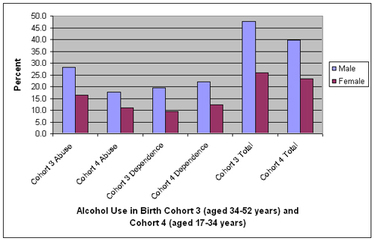The DRAM, Vol. 4(2) – Gender and drinking – Maybe we aren’t so different after all
Researchers have found men to be at greater risk for developing alcohol use disorders than women (Grant, 1997; Warner, Kessler, Hughes, Anthony, & Nelson, 1995); however, with the shift away from traditional gender roles in the United States (e.g., an increased proportion of women working outside the home, a decreased proportion of women bearing children; Thronton & Freedman, 1983), some have observed a trend toward convergence of male and female drinking patterns (Greenfield & Room, 1997). This week’s DRAM reviews a national study about the changes in drinking customs and the prevalence of alcohol disorders among men and women in the United States.
Keyes, Grant, and Hasin (2008) analyzed data from the 2001-2002 National Epidemiologic Survey on Alcohol and Related Conditions (NESARC), in which professional interviewers conducted face-to-face interviews with 42,693 civilian non-institutionalized participants aged 18 years and older. Participants responded to the Alcohol Use Disorder and Associated Disabilities Interview Schedule (AUDAIS-IV; a survey that contains over 40 questions used to evaluate alcohol use disorders). The participants reported the largest number of drinks they consumed during their period of heaviest drinking, and reported their frequency of binge drinking (i.e., 5+ drinks once per week or more often during period of heaviest drinking). To study gender differences in drinking behavior over time, the researchers divided participants into four birth cohorts: People in Cohort 1 were born in the years from 1913 through 1932; Cohort 2 from 1933 -1949; Cohort 3 from 1950-1967; and Cohort 4 from 1968-1984. The researchers divided Cohorts 2 and 3 at 1950 because previous findings indicated a greater risk of developing alcohol disorders among those born after 1950 (Johnson & Gerstein, 1998). They then divided Cohorts 3 and 4 at 1968 to specifically examine those who entered the period of risk for alcohol disorders after the 1980s (i.e., the peak of per capita alcohol consumption in the United States; Lakins, Williams, Hsiao-Ye, & Hilton, 2005).
Overall, men consumed a larger average number of drinks in one sitting (6.94) than women (2.98) during their period of heaviest drinking (a male-to-female ratio of 2.3:1). Cohort analyses suggest that consumption differences between men and women narrowed over time: from Cohort 1 to Cohort 4 the male-to-female ratio dropped from 2.9:1 to 2.1:1. Following the peak in per capita alcohol consumption in the United States, the prevalence of alcohol dependence increased from 14.4% to 17.2%, while the prevalence of alcohol abuse decreased from 22.1% to 14.3%. However, the decline in alcohol abuse among females was significantly smaller than that among males (differences of 5.3% and 10.4%, respectively) (see Figure). This trend narrowed the difference in prevalence of alcohol disorders between genders.

Figure. Prevalence of lifetime DSM-IV alcohol abuse and dependence by gender and birth Cohorts 3 and 4. Click image to enlarge.
The study is subject to the typical limitations of a cross-sectional design, such as recall bias. Further, cross-section designs are not ideal for interpreting trends. To illustrate, participants in the older cohorts might have had difficulty remembering their drinking behaviors, resulting in an underestimation of the prevalence of alcohol dependence among the older cohorts. Although these discrepancies make it difficult to compare drinking behavior by cohort, they should not confound the comparisons of interest between the genders.
Keyes, Grant and Hasin’s findings, that the differences in male and female drinking patterns are diminishing, provide support for the findings of earlier researchers (e.g., Johnson & Gerstein, 1998). The significantly smaller decrease in alcohol abuse among women in Cohorts 3 and 4 suggests that public health workers place increased emphasis on prevention efforts that target women. It is important that we continue to study these trends to gain an improved understanding about why the gender gap in alcohol disorders is narrowing, and to assure appropriate treatment for the individuals in need of treatment.
—Sara Kaplan
What do you think? Please use the comment link below to provide feedback on this article.
References
Grant, B. F. (1997). Prevalence and correlates of drug use and DSM-IV alcohol dependence in the United States: Results of the National Longitudinal Alcohol Epidemiologic Survey. Journal of Studies on Alcohol 58, 464-473.
Greenfield, T. K., & Room, R. (1997). Situational norms for drinking and drunkenness: Trends in the US adult population, 1979-1990. Addiction, 92, 33-47.
Johnson, R. A., & Gerstein, D. R. (1998). Initiation of use of alcohol, cigarettes, marijuana, cocaine, and other substances in US birth cohorts since 1919. American Journal of Public Health, 88(1), 27-33.
Keyes, K. M., Grant, B. F., & Hasin, D. S. (2008). Evidence for a closing gender gap in alcohol use, abuse and dependence in the United States population. Drug and Alcohol Dependence, 93, 21-29.
Lakins, N., Williams, G. D., Hsiao-Ye, Y., & Hilton, M. E. (2005). Apparent per capita alcohol consumption: National, state, and regional trends, 1977-2003. Rockville, Maryland NIAAA, Division of Biometry and Epidemiology, Alcohol Epidemiologic Data System.
Thronton, A., & Freedman, D. (1983). The changing American family. Population Bulletin, 39, 1-44.
Warner, L. A., Kessler, R. C., Hughes, M., Anthony, J. C., & Nelson, C. B. (1995). Prevalence and correlates of drug use and dependence in the United States: results from the National Comorbidity Survey. Archives of General Psychiatry, 52(3), 219-229.